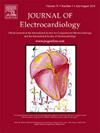New-onset T-wave inversions may predict the diagnosis of non-ST-segment elevation type 1 myocardial infarction over other causes of myocardial injury
IF 1.2
4区 医学
Q3 CARDIAC & CARDIOVASCULAR SYSTEMS
引用次数: 0
Abstract
Background
On presentation, non-ST-segment elevation type 1 myocardial infarction (T1-NSTEMI) can be difficult to distinguish from other causes of myocardial injury (OCMI) such as type 2 myocardial infarction or non-ischemic myocardial injury. New-onset T-wave inversions (NTWI) developed on electrocardiogram (ECG) soon after presentation are considered a sign of post-ischemic changes and may be useful to distinguish T1-NSTEMI from OCMI.
Methods
We assessed all cases of suspected non-ST-segment elevation myocardial infarction seen at the Baylor-St. Luke's Medical Center from 8/2018–7/2019 to determine a final diagnosis of T1-NSTEMI or OCMI. Encounters with ECGs showing T-wave inversions, ST changes, ventricular pacing, or ventricular conduction delay at presentation were excluded, as were those without a follow-up ECG within 24 h. We used adjusted relative risk analysis to assess whether NTWI was associated with T1-NSTEMI.
Results
Of 113 cases included, 33 (29.2 %) developed NTWI and 80 (70.8 %) did not. Twenty-four NTWI cases (72.7 %) and 37 cases without NTWI (46.3 %) were adjudicated as T1-NSTEMIs. The positive and negative likelihood ratios of NTWI for T1-NSTEMI were 2.27 (95 % confidence interval (CI): 1.16, 4.45) and 0.73 (CI: 0.58, 0.93). The unadjusted and adjusted relative risks of T1-NSTEMI for patients with NTWI were 1.57 (CI: 1.15, 2.16, P = 0.005) and 1.69 (CI: 1.22, 2.35, P = 0.002). NTWI had higher specificity (83 %, CI: 70 %, 92 %) for T1-NSTEMI than sensitivity (39 %, CI: 27 %, 53 %).
Conclusion
NTWI is associated with T1-NSTEMI in our study population. NTWI within 24 h on follow up ECG may help distinguish between patients with T1-NSTEMI and OCMI.

新发t波倒置可能比其他心肌损伤原因更能预测非st段抬高型1型心肌梗死的诊断
从表现来看,非st段抬高型1型心肌梗死(T1-NSTEMI)很难与其他原因的心肌损伤(OCMI)(如2型心肌梗死或非缺血性心肌损伤)区分。出现症状后不久心电图上出现的新发t波反转(NTWI)被认为是缺血后改变的标志,可能有助于区分T1-NSTEMI和OCMI。方法:我们评估了所有在贝勒st - st医院发现的疑似非st段抬高型心肌梗死的病例。在2018年8月至2019年7月期间,卢克医疗中心确定T1-NSTEMI或OCMI的最终诊断。排除出现心电图显示t波倒置、ST段改变、心室起搏或心室传导延迟的患者,以及24小时内没有随访心电图的患者。我们使用调整后的相对风险分析来评估NTWI是否与T1-NSTEMI相关。结果113例患者中,33例(29.2%)发生NTWI, 80例(70.8%)未发生NTWI。NTWI 24例(72.7%),无NTWI 37例(46.3%)被判定为t1 - nstemi。NTWI对T1-NSTEMI的正、负似然比分别为2.27(95%可信区间(CI): 1.16, 4.45)和0.73 (CI: 0.58, 0.93)。NTWI患者T1-NSTEMI的未校正和校正相对危险度分别为1.57 (CI: 1.15, 2.16, P = 0.005)和1.69 (CI: 1.22, 2.35, P = 0.002)。NTWI对T1-NSTEMI的特异性(83%,CI: 70%, 92%)高于敏感性(39%,CI: 27%, 53%)。结论ntwi在我们的研究人群中与T1-NSTEMI相关。随访心电图24 h内的NTWI有助于区分T1-NSTEMI和OCMI。
本文章由计算机程序翻译,如有差异,请以英文原文为准。
求助全文
约1分钟内获得全文
求助全文
来源期刊

Journal of electrocardiology
医学-心血管系统
CiteScore
2.70
自引率
7.70%
发文量
152
审稿时长
38 days
期刊介绍:
The Journal of Electrocardiology is devoted exclusively to clinical and experimental studies of the electrical activities of the heart. It seeks to contribute significantly to the accuracy of diagnosis and prognosis and the effective treatment, prevention, or delay of heart disease. Editorial contents include electrocardiography, vectorcardiography, arrhythmias, membrane action potential, cardiac pacing, monitoring defibrillation, instrumentation, drug effects, and computer applications.
 求助内容:
求助内容: 应助结果提醒方式:
应助结果提醒方式:


